 |
 |
 |
| |
EFFECTS OF INSULIN SENSITIZING AGENTS IN NONALCOHOLIC FATTY LIVER DISEASE, METABOLICS: metformin, rosiglitazone, metformin+rosiglitazone
|
| |
| |
Reported by Jules Levin
EASL, April 2007, Barcelona, Spain
Ziya Omer, Sevki Cetinkalp2, Murat Akyildiz1, Funda Yilmaz Barbet3, Candeger Yilmaz2, Yucel Batur1, Ulus Salih Akarca1
1: Ege University Medical Faculty, Department of Gastroenterology, Izmir, Turkey
2: Ege University Medical Faculty, Department of Endocrinology, Izmir, Turkey
3: Ege University Medical Faculty, Department of Pathology, Izmir, Turkey
Patients were randomized into 3 groups
--Metformin (M) : 1700 mg/day
--Rosiglitazone (R): 4 mg/day
--Metformin + Rosiglitazone (M+R): M 1700 mg/day + R 4mg/day
Primary objective is to investigate the effects of insulin sensitizing agents on liver histology in patients with glucose intolerance or type 2 diabetes mellitus.
Secondary objectives are to compare the effects of metformin, rosiglitazone and combination of these drugs on
--BMI
--HOMA-IR score
--Liver enzymes
AUTHOR SUMMARY
--BMI and waist circumference reduced in metformin-treated patients.
--AST and ALT levels reduced better in rosiglitazone and R+M groups comparing to metformin group.
--Activity score significantly decreased in rosiglitazone-treated patients comparing to those received metformin monotherapy.
--Histologic changes were related to ALT changes during the treatment.
--Rosiglitazone seems to be better in metabolic control and histologic improvement in NAFLD comparing to metformin. Its combination with metformin may increase the effects.
BACKGROUND
--Nonalcoholic fatty liver disease is the most prevalent liver disease.
--13-20% of adult population
--1/5 of the patients with NAFLD have steatohepatitis.
--Steatosis generally follows a benign course, but NASH is the leading cause of cryptogenic cirrhosis.
--As obesity becomes more prevalent, NAFLD and NASH are increasingly prevalent problem.
--There is no specific medication for NAFLD.
--Therapy is to correct the underlying disorders, such as obesity, diabetes, hypertriglyceridemia etc.
--Since the main cause is insulin resistance, insulin sensitizing agents seem to be a logical therapeutic approach for these conditions.
STUDY OBJECTIVES
Primary objective is to investigate the effects of insulin sensitizing agents on liver histology in patients with glucose intolerance or type 2 diabetes mellitus.
Secondary objectives are To compare the effects of metformin, rosiglitazone and combination of these drugs on
--BMI
--HOMA-IR score
--Liver enzymes
METHODS
--This is a preliminary, randomized, open label, single center study.
--Patients with type 2 diabetes or impaired glucose tolerance and biopsy-proven NAFLD were included into the study.
--Patient allocation was restricted in one year (2005).
--Those with viral hepatitis, autoimmune hepatitis, alcohol consumption (>80 g/week), HIV infection, other metabolic liver diseases, autoantibodies > 1/80 titer, were excluded.
--The patients who already use oral antidiabetics or insulin were not included into the study as well.
--The patients were given a dietery counselling and encouraged to make exercise for 6 weeks before study medication. They continued this program during entire study.
Definitions:
--DM: Fasted blood sugar > 126 mg/dl; 2 hour PP sugar >200 mg/dl
--Impaired glucose tolerance: 2 hour PP sugar 140-199 mg/dl
Patients were randomized into 3 groups
--Metformin (M) : 1700 mg/day
--Rosiglitazone (R): 4 mg/day
--Metformin + Rosiglitazone (M+R): M 1700 mg/day + R 4mg/day
The treatment period was 12 months with biochemical and clinical control visits every 3 months.
A second biopsy at the end of 1 year was offered to the patients.
Basal and end of treatment results of the following parameters were compared between the study arms.
--BMI and waist circumference
--Blood chemistry
--HOMA-IR score
--NAFLD activity score (NAS)
NAS was calculated according to the criteria of Kleiner et al. (Hepatology 2005)
NAS=Macrovesicular steatosis+Lobular inflammation+balooning
Liver biopsies were evaluated by a hepatopatholog who was unaware of the medications.
RESULTS
--A total of 68 patients were screened for the study.
--2 refused to participate the study during pretreatment period. 2 did not meet the entry criteria. 64 were randomised.
--1 patient in M arm could not tolerate metformin. It was stopped at 9th month
--1 pateint in combination group started to receive insulin at 10th month.
--Because of very high triglyceridemia, R was discontinued in 1 patient at 6th month.
--These patients were evaluated in their study arms.
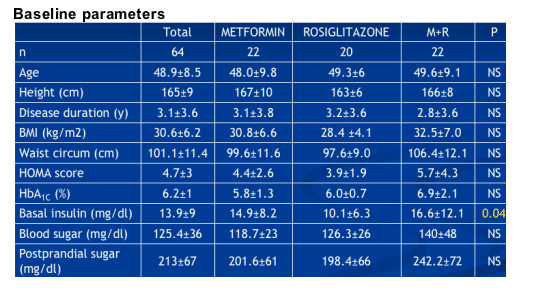
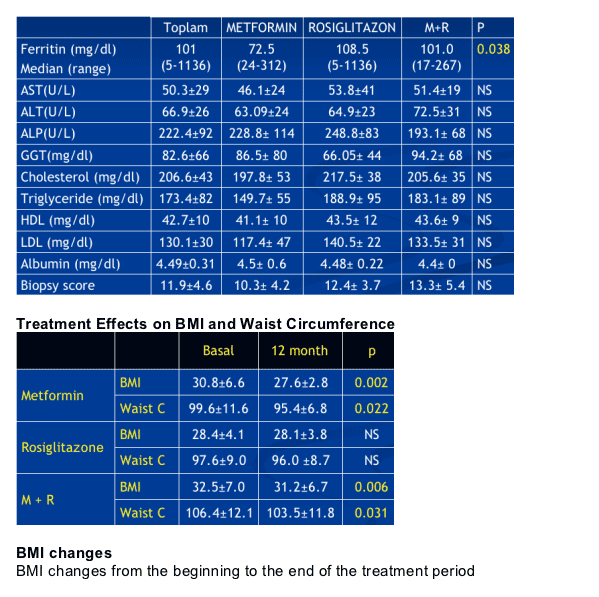
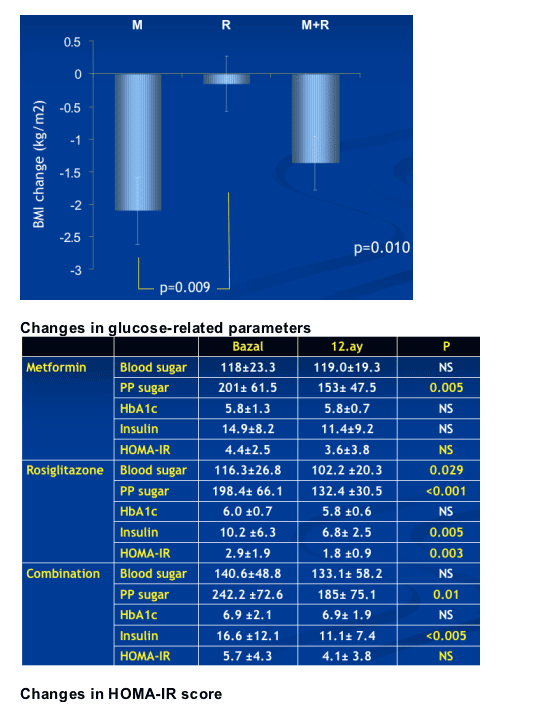
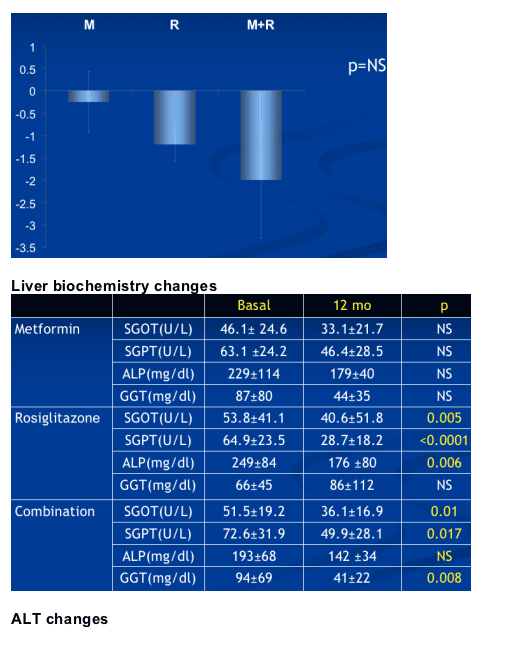
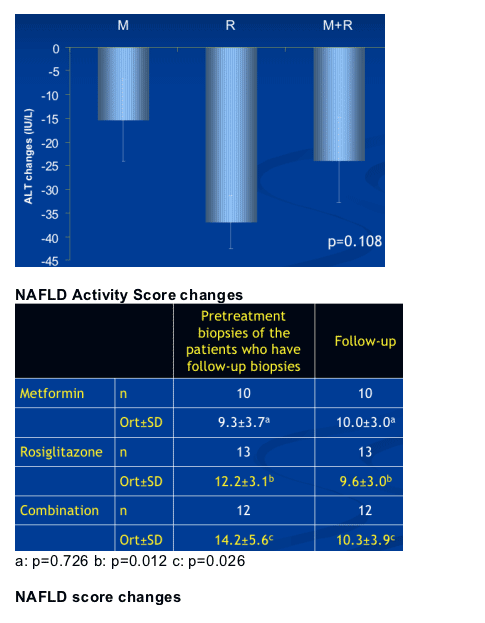

Factors related to activity score changes
Univariate analysis
--NAS changes were related to
Drug
Difference in HOMA-IR score
End of treatment AST
End of treatment ALT
Difference in AST
Difference in ALT
Multivariate analysis
--ALT changes was the only parameter related to NAS
Factors related to fibrosis score changes
Univariate analysis
-End of treatment HDL
-End of treatment ALT
-Difference in ALT level
Multivariate analysis
-Difference in ALT level
SHORTCOMINGS
--Small sample size
--Lower insulin level of R group
--Small number of follow-up biopsies (35/64)
--No placebo control and no blindness
--Selected group of patients (impaired glucose metabolism - not represent entire population)
--Larger, multicenter, placebo controlled studies are needed.
|
| |
|
 |
 |
|
|